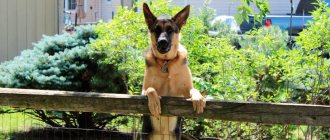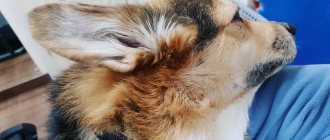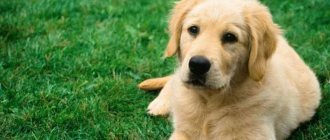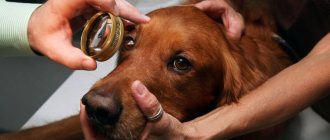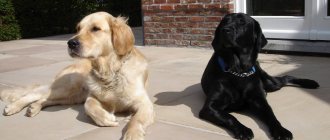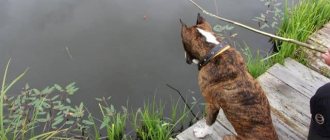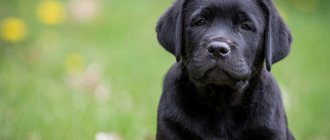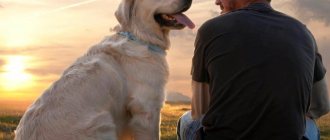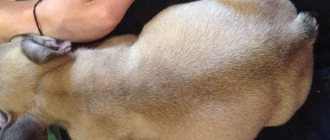Where did these dogs come from?
The Labrador Peninsula, after which the breed is named, has nothing to do with the origin of these dogs. The ancestors of Labradors are “water” dogs that lived on the island of Newfoundland. Both geographical entities now belong to Canada. It is believed that Labradors were formed from the Viking dogs who visited this island long before our era.
The first mention of these dogs was made in the report of the ship "Marigold" in 1593. At that time, the island was inhabited by a couple of species of dogs - large Newfoundlands (divers) and smaller dogs. They were also called St. John's Newfoundlands.
Indian fishermen noticed that dogs have thick hair, which allows them to withstand cold water. When going fishing, we always took our dog with us. Later, Portuguese fishermen also liked the breed. They took 2 dogs with them in case of a shipwreck. To escape, they used a rope, the ends of which were held in the dog's teeth. Thanks to this approach, the team managed to swim to shore.
The dogs really attracted British sailors, who began to export Labradors to England. The first individuals arrived in England in the 1810s. The dogs were popular with hunters because they were good at catching ducks. Initially, only black Labradors were recognized, later fawn and chocolate colors were added to the standard.
History of the Labrador Retriever breed
History of the breed
The first mention of Labradorite dates back to 1593. In a report on the voyage of the Merigold in the Cabot Strait area, the crew met “natives with their black dogs, smaller than a greyhound, who followed on their heels.”
In 1662, W. E. Cormack, a native of St. John's, Newfoundland, traveled on foot around the island and subsequently described the small dogs he saw - "excellently trained as retrievers (retrievers) in catching birds, dogs with short hair are preferred because in frosty weather, long the wool becomes covered with ice when leaving the water.”
These were the dogs of St. Joihns, which were used in fishing and hunting: helped to pull nets out of the sea and catch fish that jumped out of them, to carry land and waterfowl during the hunt.
Over time, Newfoundland water dogs were divided into two similar groups. At the same time, water dogs on the island performed very specific work functions, serving fishermen for specific purposes. The first type of dogs were powerful black dogs. They were practically no different from modern Newfoundlands. These dogs were used on the island to transport cargo and fish in small two-wheeled carts.
This was their main job. It was suggested that these dogs also carried out rescue service, pulling people out of the water. They were allegedly used even by looters to remove cargo from sinking ships that were wrecked off the coast of the island. However, strange as it may seem, most Western dog experts refute this theory.
So, D. Griffin believes that these dogs were extremely massive and heavy, even small waves “twisted” them. The dog quickly lost strength and could not resist the elements. Another type of dog from Newfoundland is the so-called St. John's. He was much smaller than his brother and lighter in type. Its size was approximately that of a pointer. The color was also black, and the coat was dense and oily to the touch, absolutely impenetrable to water. Wool gave dogs great advantages, because... When leaving the cold water, it was not covered with crusts of ice. The dog floated, according to eyewitnesses, like a piece of lard. This living float could remain among the waves for a very long time, it seemed that neither cold nor fatigue took it. Literally a water dog. During the migrations of waterfowl, in spring and autumn, the dog was an indispensable assistant to hunters - it was persistent, an excellent swimmer, and effortlessly carried away a downed bird the size of a goose. Even then, these dogs were called retrievers - wide chested, powerful with excellent muscles and well-shaped limbs, slowly and persistently doing their work, with a good-natured temperament and a desire to please people. In the off-season, they also did not sit idle, faithfully serving the fishermen: they helped pull out nets, retrieved dropped objects from the water, even rushed into the water after cod jumping out of boats and retrieved mooring lines from the sides of fishing barges and ships. Fishermen valued dogs very much. Dogs were irreplaceable helpers, had a wonderful character, were not malicious, were friendly to people, quickly learned commands and elements of training, and were fun for children.
Drawing of a retriever on the hunt
Early books on hunting dogs contained pictures of retrievers, most of them smooth-haired with a feathery tail. They looked more like modern Flat Coated Retrievers, while the head resembled today's Labradors. One of the early woodcuts shows a black dog with a deep body, a thick, heavy coat and rich feathering and is written that it is a St. John's dog, or Labrador. In 1832, another illustration appeared, depicting a black and white or tricolor male with feathering. It was an imported Labrador purchased at Poole Harbor and presented to Colonel John C. Coates. Coates's Flat-Coated Retriever, which won the 1905 show, was his descendant. In the 19th century, the type of retriever began to take shape, but its varieties, so well known to us today, did not yet exist. There were no tribal books, and the landowning nobility carefully guarded their livestock. The huntsmen managed the matings. Labradors have been crossed with water spaniels, setters, pointers and Newfoundlands. Huntsmen bred dogs based on their working qualities. Hunters were not interested in uniformity of type or breed standard.
Labradors in England
At the beginning of the 19th century, long-haired dogs that were exported from Newfoundland were a symbol of the well-being of the English aristocracy.
Colonel Peter Hawker
Colonel Peter Hawker, a sea captain and owner of fishing boats, became one of the Labrador's admirers. He was one of the first to import ancestral dogs “of the correct type, black, active, with otter-like hair” into the UK.
St. John's dogs were the favorites of the whole team and the pride of the captain. They were given to English families as exotic and original gifts. Children happily accepted loving and funny dogs. They tolerated everything from the kids and showed miracles of tolerance when they were even dragged by the “otter’s” tail. With their unusual appearance, they aroused curiosity and were representatives of a different, unfamiliar world. The abilities of fetchers also aroused the interest of hunters. The fame of Newfoundland dogs quickly grew. Over time, the popularity of dogs among duck hunters became so high that many already ordered dogs from the island. In “Instructions for Young Sportsmen and All About Hunting and Hunting Arms” by Peter Hawker of 1814, it is written: “...much more suitable for hunting; more often black than other colors, not much larger than a pointer; with a long head, deep chest, strong legs, short smooth hair, the tail is not carried high and is extremely fast in running, swimming and hunting.”
The British nobility were delighted with dogs. The hunting merits of Labradors were appreciated in many counties, and the Labrador soon became a strong competitor to setters and pointers. Since 1779, Newfoundland dogs have been well known.
The Earl of Malmesbury at Heron Court used St. John's Newfoundland dogs for shooting sports as early as 1809. The 2nd Earl of Malmesbury (1778-1841) and his son the 3rd Earl of Malmesbury (1807-1889) imported and bred St. John's dogs. Johns with Fr. Newfoundland. In a letter dated 1887, the 3rd Earl of Malmesbury wrote: “We have always called my dogs Labradors, and I have kept the breed as pure as it was in the days of the brisk trade with Newfoundland, ever since I brought the first Labrador from Poole. Those Labradors were known for having a waterproof coat and, above all, an otter-like tail.”
In the photo Nell is 12 years old, she belonged to Earl of Home (1799-1881)
Wolters stated in his book that these are the earliest photographs of a Labrador retriever, taken in 1867. This (St. John's) dog was part of the breeding stock used to breed Labradors and had white hair on the tips of its paws and around the muzzle. This trait was also noted in some other Labradors that were bred in 1800 in England.
The family books of the Malmesbury dynasty contain the first records of such Labrador retrievers as Lord Malmesbury Sweep (1877) and Lord Malmesbury Juno (1878). Their direct descendants - Buccleuch Ned (1882) and Buccleuch Avon (1885) - (Malmesbury's Tramp 1879 & Malmesbury Juno 1880) are the ancestors of all Labradors.
Malmesbury gave the Dukes of Buccleuch and of Home some of their dogs to continue the breeding work. These dogs were Ned (1882) and Avon (1885). Many argue that these two dogs served as the basis for all English Labradors.
Ned (1882) and Avon (1885)
Buccleuch Avon was one of the founders of the modern Labrador, and he carried the "liver gene" - the chocolate gene. He is considered the ancestor of all chocolate Labradors. There are many sources that indicate that Buccleuch Avon produced “liver colored” puppies. "Liver" is the term used for chocolate Labradors. The Buccleuch kennel did not use these puppies for breeding; they were given to friends and families as pets. At the time, breeders were trying to perfect the black line of dogs. However, Avon did pass on his chocolate gene as a recessive trait to many of his black offspring.
Jack Vanderwyk has conducted genetic research on Labradors around the world and proposes at least 8 gene pathways for modern Labradors from Buccleuch Avon. For the most part, all paths go from Buccleuch Avon. — Origin of Chocolate Labradors, Jack Vanderwyk.
In 1835, the kennel Walter Francis Montagu Douglas Scott (1806-1884), the 5th Duke of Buccleuch and 7th Duke of Queensberry - “Buccleuch”, specializing in breeding Labradors, began operating in Scotland.
Lord John Scott also began importing dogs
Lord John Scott, the 10th Earl of Home (brother of the 5th Duke of Buccleuch) also began importing St. John's from Newfoundland. These were Jock, Nell (1843) and Brandy. Brandy received his name on board a steamship crossing the Atlantic Ocean. The dog jumped overboard into the ocean waters to retrieve and bring back the cap of one of the crew members. It took more than two hours to pick up the “hard-working Labrador.” The dog was exhausted and was restored with the help of brandy. The Buccleuch kennel can be called unique, since at the beginning of its development of St. Joihns were not mixed with English hunting dogs.
On the lines of Buccleuch, A. Holland Hibbert (Viscount Knutsford, future Lord Knutsford) founded the large nursery “Munden” in 1880. At field trials in 1904, his black male Munden Sentry (Munden Sixty 1897 & Munden Scotty 1897) and black female Munden Single (Munden Sixty 1897 & Munden Scotty 1897) especially distinguished themselves.
In her book The New Complete Labrador Retriever, published in 1968, Helen Warwick writes: “In 1904, Munden Single, a black female A. Holland-Hibbert (Lord Knutsford), was the first Labrador to be field tested in England. At the International Gun Dog Trials in Sherborne she won a certificate of merit (CM-Ctrtifikate of Merit). Munden Single participated in other trials and was so loved that after her death, her stuffed animal was placed in the British Museum so that they could see what a Labrador should be like. Judging by many responses, she deserved much more, since “this beautiful and intelligent creature had a gentle and kind character that led to admiration, and her style of work was extremely attractive.” After the Second World War, the Munden Single was placed in the Tring Museum."
During her lifetime, she produced outstanding offspring, distinguished by beauty and intelligence - true dual-purpose Labradors who won both in field trials and in the show ring. Lord Knutsford created a magnificent line of Labradors, represented in the pedigrees of all modern Labradors.
On April 4, 1873, the Kennel Club (England's Kennel Club) was founded.
Kennel Club (England's Kennel Club).
The club kept records, set breed standards, monitored the purity of breeds, and also dealt with issues of conducting tests and beauty exhibitions.
In 1880 the Kennel Club introduced a dog registration system. Thus, the recording of lines began and, as a consequence, from this moment the concept of English ancestry began.
In 1895, a league of gun dogs was officially created in England, which included Labradors. The consequence of its creation was the conduct of active field tests.
Major C. E. Radclyffe, son of von C. J. Radclyffe and father-in-law of von Mrs. Audrey Radclyffe, who would later be associated with the famous Zelstone Kennel, owned the first Kennel Club registered yellow Labrador, Ben of Hyde, born in 1899 (KC556998). "Ben" and his sister, the yellow "June" were born from a mating of pure black parents - (Radclyffe's Neptune x Tapper's Duchess). "Neptune" and "Duchess" were descended directly from dogs originally imported from Newfoundland. Thus, there is no doubt that the recessive gene for yellow color appeared in England with the St. John's dog. Ben had many matings to black bitches and passed the yellow color on to the next generation. Even in his offspring, he had a significant number of yellow dogs, and his sister “June”, despite several litters, did not have yellow offspring.
Major Wormald with a group of yellow labradors
Even Hugh, 5th Earl of Lonsdale had a yellow Labrador, from the kennel of Major C. E. Radclyffe. Due to his passion for all things yellow, he became known as the "yellow" Count. Lord Londsdale founder of the Lowther nursery. In addition, he was the first president of the Yellow Labrador Club, which was founded in 1924. The club was co-founded by Veronica Wormald and her husband Major Wormald - they were co-chairmen of the Yellow Labrador Club from its founding in 1924 until Veronica's death in 1979.
Veronica Wormald was delighted when she saw her "first" yellow, almost rusty Labrador, a female named "Pink", owned by Colonel Swan (Swan's Pink). She later bought one of the dog's granddaughters, a black female named Velvet. In 1910, "Velvet" and "Ben of Hyde" were mated, and two yellow puppies were born in the litter - "Mannie" and "Molyneux's Sam". Velvet became the founder of the Knaith nursery in Scotland.
From 1870 to 1900, 112 Labrador retrievers were officially registered in England. After half a century of selection in compliance with all rules of recording and data processing, on July 7, 1903, the Kennel Club (England's Kennel Club) recognized a new breed - Labrador.
On October 12/13, 1900, the first official field trials for retrievers took place, organized by The International Gundog League Retriever Society.
1907 was also an important year for Labradors. For the first time, a woman took part in field trials of retrievers - Nina Douglas-Hamilton, Duchess of Hamilton and Brandon with her black bitch - Dungavel Juno (1906), who received the 3rd prize Non-Winner Stake in earlier field trials trials organized by the Scottish Field Trials Association.
Nina Douglas-Hamilton, Duchess of Hamilton and Brandon
In 1912 She was the founder of the Scottish Society for the Prevention of Vivisection, later Advocates for Animals. In 1939, the Duchess founded the Ferne Animal Sanctuary.
January 9, 1909 The First Retriever Championship took place in (Havant in Hampshire) organized by the IGL International Gundog League Retriever Society - the winner (The IGL Retriever Championship Winner) was the Duchess's bitch "Dungavel Phoebe" daughter (FTCH Flapper x FTW Dungavel Juno). The Duchess's appearance at the field trials showed that it was an acceptable activity for Edwardian ladies.
November 26/27, 1907 The 2nd All-Aged Stake, held by the Kennel Club, took place. 20 dogs took part - 15 Flat Coats, 3 Labradors and 2 other retrievers. Labradors - Flapper (1902 - owner of Mr. Portal's), Dungavel Juno (1906 - owner of The Duchess of Hamilton's), Munden Single (1900 - owner of Holland-Hibbert's). Im. - "Flapper", IIm. - "Dungavel Juno", IVm. - "Munden Single". This was the first time that a Labrador became the Winner of a field trial conducted by the English Kennel Club!
Eng. FT Ch. Flapper (1902) (Barnett's Stag x Bates Batsey) was 5 years old when he became FT Champion. He was one of the most outstanding males in the breed. In field trials, Flapper outperformed all other dogs and, according to historian Mr. C. Mackay Sanderson, "he was the unsurpassed star of the first magnitude in the history of the breed."
In 1909 Mr.Captain Archibald Edward Butter, 12G Grandson, M. made his “debut” as a Labrador handler. His work with Peter of Faskally revealed a wonderful partnership - a magnificent dog in the hands of a talented leader!
FT. Ch. Peter of Faskally (1908) born to (Waterdale Gamester and Birkhill Juliet) breeder - Mr. Geo. Watson, owner -Mr. AE Butter CMG in 1911 , won the Retriever Championship in Fakenham (for the first time only Labradors participated). His daughter “Gwendoline” (FT Ch Peter of Faskally x Juniper *1907) (owner Capt. Glen Kidston) was second.
FT. Ch. Peter of Faskally
FT. Ch. Peter of Faskally was an outstanding dog and he left his mark on the history of the breed.
From 22 matings, no less than 32 of his offspring were field trial and championship winners.
In 1913, 14 field trials were conducted involving 247 dogs, of which 50 were Flat-Coats, 13 Golden Retrievers, 1 Curly Coat, and 179 Labradors.
The outbreak of the First World War in 1914 led to a reduction in field tests and they ceased to be carried out in 1915.
In April 1916, the Munden Labrador Club was founded in England, headed by President A. Holland Hibbert (Lord Knutsford), a post he held until his death in 1935. and secretary to Mrs Dick (Lorna Katherine Curzon Howe, Countess) she held this post for 45 years. Such luminaries as Lord Chesterfield, Lord Lonsdale, Lord Vivien, Lord Harlech, Mr B. Coutts of the London Police, Mr A. Nicol and Mr R. Heaton sat on the committee. In July 1916 they wrote the breed standard. While developing it, they made one basic requirement for the breed - that the Labrador be a working dog, a retriever without equal, an intelligent and kind companion, with whom the owner would not be ashamed to appear in any company. The club became the center for the development of the breed, with special emphasis placed on to organize field trials and represent the interests of the breed in the Kennel Club. As the years have passed, many other clubs have been formed to promote Labrador Retrievers, mainly local ones, but there is no doubt that winning the Labrador Retriever Club trials or a certificate of conformity at the championship remains an exceptional reward.
One of the most devoted enthusiasts of the breed was Lorna Katherine Curzon Howe , Countess.
Lorna Katherine Curzon Howe with a group of Labradors
Lady Howe was a passionate fan of the breed. She seemed to know every Labrador in the country and every recent litter, and could tell from one look at a dog whether it would be a show champion or a field trial winner. Therefore, many breeders refused to give away puppies until Lady Howe examined the entire litter. Thanks to her abilities, she gradually created her Labrador kennel “Banchory”, choosing the best dogs in the country of both types, both show and field trials, and crossed them with each other for several years. Many outstanding breeding dogs have been owned by Lady Howe, winning numerous Crufts and field trials. She knew how to arouse interest in the breed and encouraged beginning breeders. Throughout her life, Lady Howe judged at shows and field trials and held leading positions in the Labrador and Kennel Club.
Her first Labrador was a black male Eng. FT Ch. Scandal of Glynn (1913)(Eng. FT Ch. Peter of Faskally 1908 x Shelag of Glynn 1911) breeder Lord Vivian. After Scandal of Glynn's death, Lady Lorna decided to find the only male pup that Scandal of Glynn had sired - Bolo.
Dual FC CH Banchory Bolo (1915-1927) came to Lorna when he was almost 2 years old, after several trainers refused to work with him due to his aggressiveness, he was given to Lorna for free, but with the caveat that if she did not want later, it must be destroyed. Bolo's original name was Caerhowell Bully, bred by Sir John Banner. Lady Howe saved his life by nursing him twice during serious illnesses. This made them friends. Having become stronger and believing in himself, Bolo got to work. At the age of 5 he began to participate in field trials and in 1920. was awarded the title of Champion. 2 years later he became a Double Champion. Historian Mr. C. Mackay Sanderson in his “Studbook and Achievements in Field Trials of Labrador Retrievers,” published in England in 1949. writes: “In order to properly assess the impact on the breed of Malmesbury's Tramp (1879) blood, it is necessary to separately consider the FT line. Ch. Peter of Faskally, who vividly embodied the Dual Champion - Dual FC-CH Banchory Bolo via Eng. FT Ch. Scandal of Glynn (1913). In the 40-odd years between the birth of Malmesbury's Tramp and the advent of Bolo, there was not a single male that had such a profound impact on the breed. He breathed new life into the breed, the fame of this dog both as the Winner of exhibitions and field trials, and as a producer gave the breed a powerful impetus. That is why his name is written with a golden stroke in the history of Labrador retrievers. The merits of this beautiful dog are admired when you remember the subsequent revival of the breed.” Many top dogs have Banchory blood in their veins.
Bolo, unlike his sons, did not give yellow puppies.
Dual FC-CH Banchory Bolo
Son of Bolo, CH FTW "Banchory Danilo" (1923 Blk-cy) (Dual FC-CH Banchory Bolo x Munden Scarcity) by breeder Lord Knutsford (Munden Kennel), despite the fact that he was black, carried the genes of yellow and chocolate color. He had a record list of exhibition victories, including Kraft's. America's first field trial champions trace their lineage directly to Danilo. Some chocolate Labradors are known to trace a line back to FT.CH "Banchory Night Light Of Wingant" from Banchory Kennel. He was a black male born in 1932 in England.
Night Light comes from the line of Double Champion Banchory Bolo, who was a carrier of the chocolate gene by inheritance from Buccleuch Avon. The Banchory Bolo was also known for having white hairs on the soles of its feet. Which are currently called the “Bolo trail”.
Thirty years later, with her talented gamekeeper T. Gaunt, and then with the world famous Gwen Broadley (Sandylands Kennel) as a partner, Lady Howe Labradors have earned titles: 4 Double Champions, 29 Show Champions and 7 Field Champions.
Other remarkable dogs from this kennel are Dual Ch "Bramshaw Bob", winner of Best in Show at the Crafts Show, London 1932 and 1933; his father, CH “Ingleston Ben” (in 1933 Lady Howe purchased a black male, champion Inglestoon Ben, bred in Scotland by Mr. Dawby. This Labrador had both working and show qualities, moreover, he was a producer of excellent males and females), field Champions "Balmuto Jock" and "Balmuto Hewildo", DualCh "Banchory Painter" (L'ile Buster Bill).
The Labrador has achieved its preeminent position in the world of gundogs thanks in large part to the great merits of Lady Howe. Historian Mr. C. Mackay Sanderson, in the Labrador Retriever Stud Book for 1949, writes about Lady Howe: “Undoubtedly, she has been the best and most useful friend of our breed for the last 25 years, her energetic promotion of the interests of the breed, constant success at shows and support of the field tests greatly contributed to the emergence of interest in Labradors and the growth of their popularity.”
origin of name
The version of the name from the Labrador Peninsula is unlikely. It is believed that Newfoundland was still its homeland.
The main color was black - it was very similar in color to the mineral labradorite. There is also a version that the name of the breed was given by the Spaniards for their high ability to work - labrador translates as hard worker.
The recognized name of the breed is Labrador Retriever. Retriever translates to “bringing killed game.”
